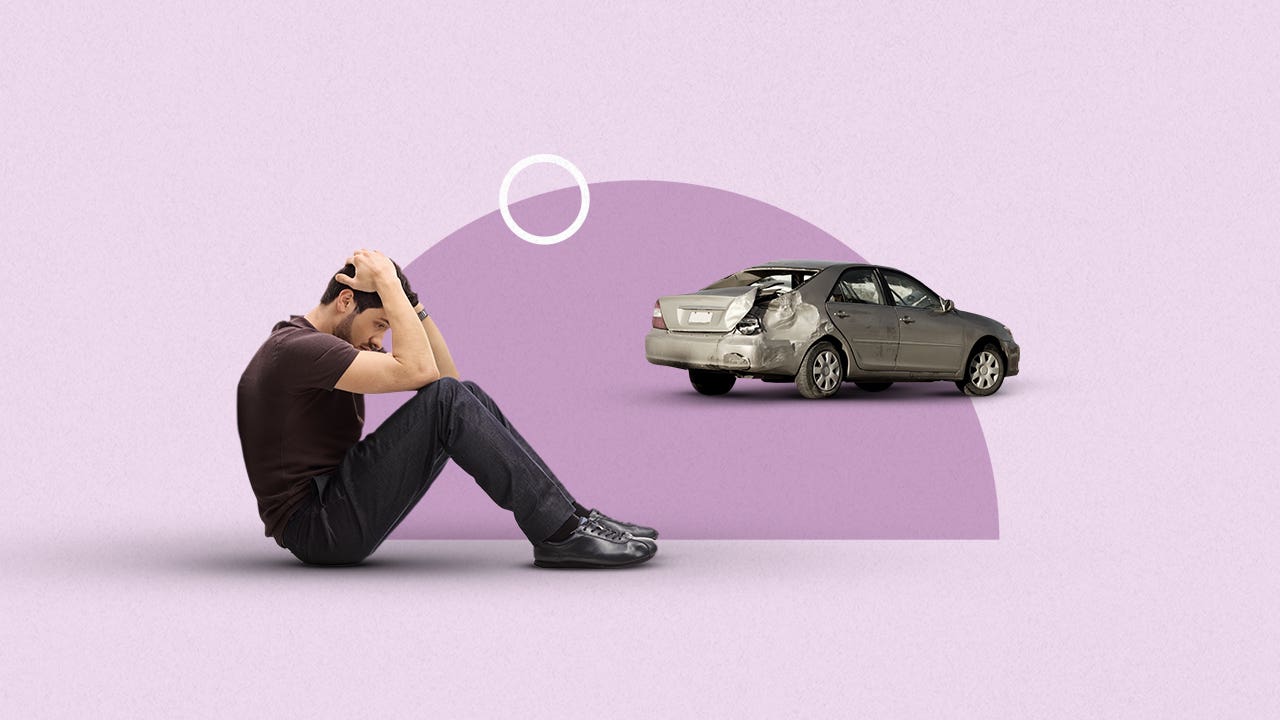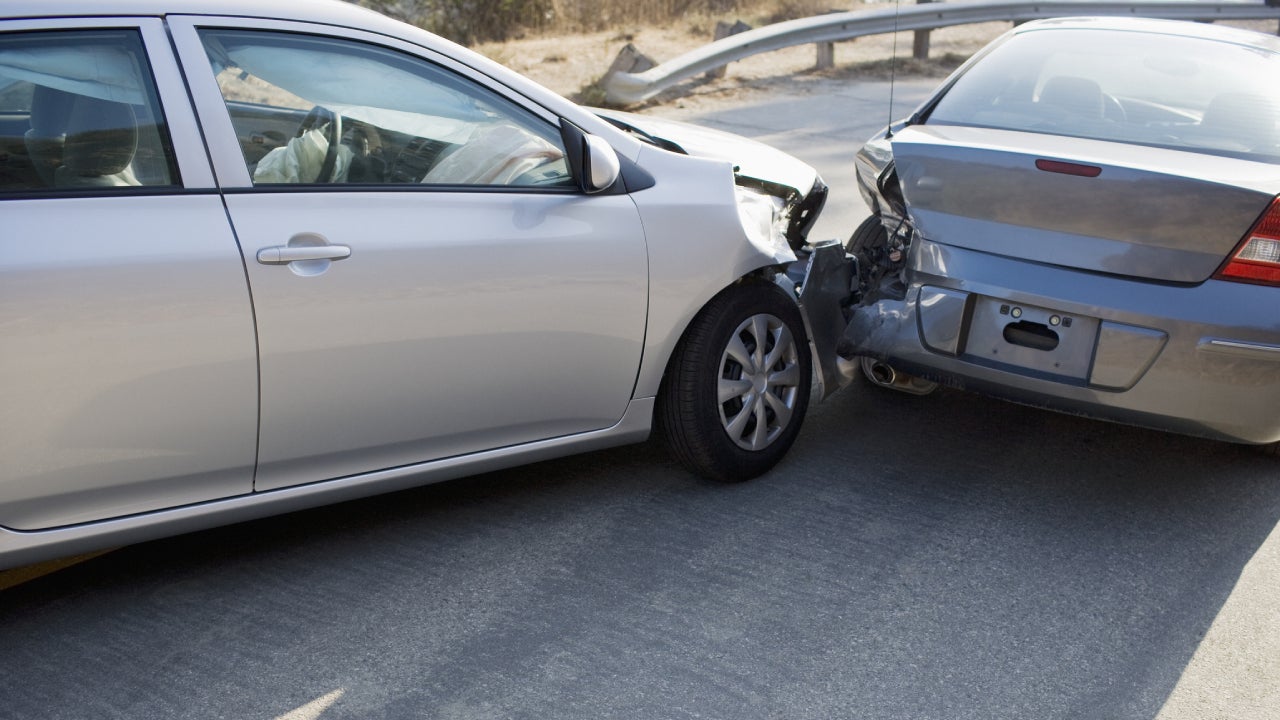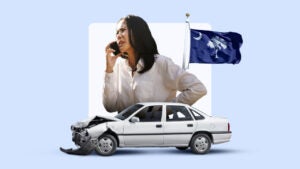Managing trauma after a car accident

If you have experienced a car accident, you know that it is a frightening and stressful experience. There may be damage to your car or other objects, and injuries as well. Emergency providers will help with physical injuries as quickly as they are able to, but some injuries are invisible to the eye. Many individuals deal with emotional trauma after an accident. It can impact their daily life in a variety of ways, and may make it harder to get behind the wheel again. Below, Bankrate’s insurance editorial team takes a look at what you can do to minimize psychological trauma and return to normalcy as quickly as possible following a car accident.
What happens immediately after a crash?
Immediately after a car accident, some drivers may find themselves in shock. Even if you typically know what to do after a crash, you might not remember in the moment. Here are the steps you might want to consider taking after getting into an accident before you leave the scene and afterward.
At the scene
If you get into a car accident, consider these steps while you remain at the scene:
- Call 911: Pull over to a safe area if possible and immediately call 911. Even if the crash was minor, most insurance experts recommend that you contact the authorities for an official police record of the damage.
- Check for injuries: Assess any injuries that you, your passengers and other drivers might have. If anyone needs emergency medical treatment, you can ask the 911 operator to send an ambulance or the responding police officer can request aid.
- Exchange information with other drivers: Exchange information with the other drivers involved in the crash. Make sure to write down their full names, addresses, phone numbers and insurance information. This will help with the insurance claims process later on.
- Write an accident statement: Depending on the situation, it might be a good idea to write down a statement of what happened in the accident and collect statements from other drivers involved. If the police arrive, they will take statements and file an official police report.
Following the crash
After a car accident, you will want to start the insurance claim process as soon as possible. Depending on who is at-fault in the accident, the claim or claims will either be filed with the other driver’s insurance, yours or both. If the other driver is at-fault, but does not have sufficient coverage, you may be able to file a claim with your insurance company to cover the damage. Here are some tips before and after filing a claim:
- Gather information for your insurance company: Before you contact your car insurance company, spend some time compiling the information you will need for the claim. This includes the police report, photo evidence from the scene, copies of your medical treatment if you were injured and statements from all drivers involved. The more information you can provide, the better your insurance provider will be able to evaluate the situation accurately.
- File an insurance claim: The next step is to notify your insurance company of the accident. An agent will walk you through the process of filing a claim, and they can also review your policy to determine what is and is not covered and how much money you could be eligible to receive.
- Receive your insurance payout: If the claim is approved, you or the auto shop doing your car repairs will receive your payout, minus your deductible (if you have one). Typically, collision and comprehensive insurance require a deductible, which is taken out of your claim payout.
Nervous to drive after an accident? You aren’t alone.
If you think you’re the only person dealing with post-accident anxiety, you are not the only one. Many drivers feel uneasy getting behind the wheel after a car accident. Data shows that many drivers suffer from psychological trauma stemming from a crash even if they aren’t seriously injured physically.
For many, driving is something they do every day, and it can be easy to forget that it can be dangerous and sometimes deadly. In 2021 alone, more than 5.4 million people were injured in car accidents. Even minor accidents can lead to psychological distress and lingering trauma, such as:
- Mood swings, causing feelings of anger, frustration and guilt
- High levels of stress and anxiety that don’t go away
- Difficulty sleeping, including insomnia and recurring nightmares
- New fears and phobias, such as a fear of driving or riding in a car
In addition, many drivers experience post traumatic stress disorder (PTSD) after a serious motor vehicle accident. Data shows that between 25-33 percent of drivers display PTSD symptoms at least 30 days after a serious crash. Among accident survivors that suffer from PTSD, more than half have been shown to have mood disorders, and many have symptoms of a major depressive episode.
Tips for reducing stress and anxiety after a car accident
If you’ve been in a serious motor vehicle accident, feeling stressed or anxious to drive again is a normal response. However, being stressed can actually impact the way you drive. When you are experiencing heightened emotions or mental distress post-accident, you could be more likely to drive below the speed limit, slam on the brakes or perform other unsafe driving habits due to the fear of another crash.
To ease your stress around driving, you may find that counseling or therapy is necessary. In addition to professional help, there are various other free ways to cope that can be done at home. For example, journaling can be a great way to process your emotions, identify your triggers and track your symptoms.
Taking care of your mental health after a car accident is extremely important. There are also a few strategies you can adopt to reduce your risk while driving, which could potentially lower the chance of another crash. Here are Bankrate’s top six tips for reducing risk while driving under stress:
- Practice being in your car: It may sound silly, but simply sitting in your parked vehicle may help assuage some of your driving anxiety. Taking a moment to re-familiarize yourself with your vehicle might help you regain some of your driving confidence and make getting back behind the wheel feel less intimidating.
- Take deep breaths: While you are driving, taking deep breaths can make a big difference in your mood. It signals to the body that you are safe, which can help you relax, so you avoid making potentially dangerous maneuvers.
- Listen to a podcast or music: Although you should always be attentive when you drive, consider listening to a podcast or your favorite album to help distract you from anxious thoughts.
- Sit in a comfortable position: Being in a comfortable position when you drive is very important because it can help you feel more at ease. Avoid gripping the steering wheel too tight or clenching your jaw, which can make your body feel tense. Make sure your mirrors and seat are adjusted to your preference before you begin driving.
- Get enough sleep: Driving while you are tired increases the likelihood of an accident, so make sure you are getting enough sleep before you drive. Data from the National Safety Council shows that driving after going more than 20 hours without sleep is equivalent to driving with a blood alcohol content of 0.08 percent. You should also avoid drinking lots of caffeine to stay awake, which can make you feel even more anxious and jittery.
- Leave extra space between cars: If possible, keep adequate distance between your car and others. One way to do this is called the three second rule. Pick a landmark, such as a street light or sign, and see how many seconds it takes between the car ahead of you and your car to pass it. Aim for at least a distance of three seconds between the two cars.
Safe driving tips
After a car crash, it’s a good idea to review the foundations of safe driving, whether you were at fault or not. In most cases, accidents are preventable. Taking the proper safety precautions can help you avoid a crash, or lower your risk of a serious accident with injuries. Here are some safe driving tips to remember before you get back in the driver’s seat:
- Always wear your seat belt: Not only is wearing your seatbelt a legal requirement, but it can also save your life in a car accident. In 2021, 57 percent of fatally injured passenger vehicle occupants aged 13 and older were not wearing seatbelts. That same year, 55 percent of fatally injured drivers were unbelted.
- Obey traffic signals: Remember what you learned in driver’s ed about following traffic signals. Don’t be tempted to speed up at yellow lights and drive straight through stop signs. These signs are meant to keep drivers safe on the road, so it is important to follow them correctly, even when other cars are not around.
- Don’t drive over the speed limit: Over the last 20 years, speeding has been a factor in roughly one-third of all fatal car accidents. When you drive too fast, it becomes harder to stay in control, which can increase the risk of a collision. Make it a point to avoid driving over the speed limit, even if you’re in a hurry.
- Avoid rush hour when you can: Avoid driving during rush hour whenever possible. During rush hour, traffic is stop and go, and often, bumper to bumper. It can be more difficult to avoid accidents during the evening work commute, especially when people are not paying close attention.
- Limit distractions in the car: Distracted driving is one of the leading causes of car accidents, particularly among young drivers. Texting, taking a phone call, eating and putting on makeup are all forms of distracted driving that can increase your chance of an accident. Limit distractions in the car at all costs.
How to feel more comfortable riding in someone else’s car
After a serious motor vehicle accident, you may find that driving isn’t your only fear. You might also be nervous to ride as a passenger in someone else’s car. For some people, riding as a passenger can be even more nerve-wracking because you have to put your trust in the other driver. Here are a few ways to make yourself feel less uneasy about riding with other people:
- Accept the fear: It can be difficult to deny the fear of riding as a passenger with someone else, whether it’s an Uber driver, a friend or your spouse. However, denying your fear can make it harder to conquer in the long run. Mentally acknowledging your fear can help you to overcome it.
- Distract yourself: In the car, find ways to distract yourself from your anxiety. Consider reading, texting a friend or listening to music. If you get car sick, listening to a podcast is a great way to distract yourself without looking at your phone or a book.
- Take a test drive with the other driver: If you have a car trip planned with another driver, ask them to take a test drive so you can experience riding with them in a safe setting. It will also give you an opportunity to discuss your fear with them, so you can work together to make yourself feel as comfortable as possible.
- Ride in the backseat: Generally speaking, the passenger seat is the most dangerous spot in the car if you get into an accident. Riding in the backseat can be much safer, which might make you feel less anxious.
- Try Cognitive Behavioral Therapy (CBT): CBT is a form of psychotherapy that can help alleviate mental disorders like depression and anxiety. This treatment aims to help you reshape your negative thought patterns and find healthier ways to cope with distressing beliefs. By working with a CBT-trained therapist, you can learn to reframe your negative thoughts about driving or being in the car so you can face your fears.
- Look into Neuro-Linguistic Programming (NLP): NLP is another therapy technique that is used to change people’s negative thought patterns. It can help you overcome limiting beliefs, deal with distressing situations and improve your mindset overall.
Resources for managing trauma after a car accident
There are dozens of resources available to help you overcome your trauma after a car accident. Here are a few:
| Topic | Resources |
|---|---|
| Find a professional |
Psychologist locator — American Psychological Association Psychiatrist locator — American Psychiatric Association |
| PTSD |
National Center for PTSD Anxiety and Depression Association of America — PTSD resources |
| Managing trauma | National Alliance on Mental Illness — 7 tools for managing traumatic stress SAMHSA — Coping tips for traumatic events and disasters |
| Mobile apps to help with stress and anxiety |
Headspace (Meditation and mindfulness tools) Calm (Number one app for meditation and sleep) Breathe2Relax (Breathing exercises to curb flight-or-fight response) Happify (Helps users take control of their emotions to overcome stress) |
Frequently asked questions
-
-
It completely depends on the individual. Some people may feel fine getting back behind the wheel shortly after a serious crash, while for others, it can take much longer to feel safe even being in a vehicle. Taking actions to address your trauma may help you adjust to driving again after an accident. If your driving-related trauma is interrupting your life, you might consider speaking with a therapist or licensed counselor.
-
One of the best things you can do for someone dealing with car accident trauma is to let them know that you are there for them and ask how you can be helpful. Running errands for them, offering to meet up for lunch somewhere they can walk to or simply listening when they need to talk may all be helpful.
-
Some car crashes are unavoidable, as you cannot control another driver’s actions or random occurrences, like an animal running out into the road. With that in mind, to help avoid accidents, focus on the factors that are within your control. Limit distractions, practice defensive driving habits, obey the laws of traffic, maintain a safe following distance and signal turns to other drivers for starters. Importantly, never get behind the wheel if you have been drinking.
-
Accident-related PTSD may manifest itself differently for each individual. For some people, there can be flashbacks or nightmares that force them to relive the accident in their minds. Others may experience negative thoughts about themselves or the world around them, or feel anxiety around experiences that formerly would not bother them. They may deal muscle tension or gastrointestinal issues, and could experience social challenges that lead them to withdraw from or disconnect from friends and family. There is no single symptom that is always present. A qualified health practitioner can help a person identify and work through the symptoms of PTSD after a car accident. In some cases, medication or other interventions can also help manage symptoms.
-
You may also like

What does no-fault state mean?

What to do if the life insurance company denies your claim

What to do after a hit-and-run in South Dakota

Car insurance after a hit-and-run in South Carolina


